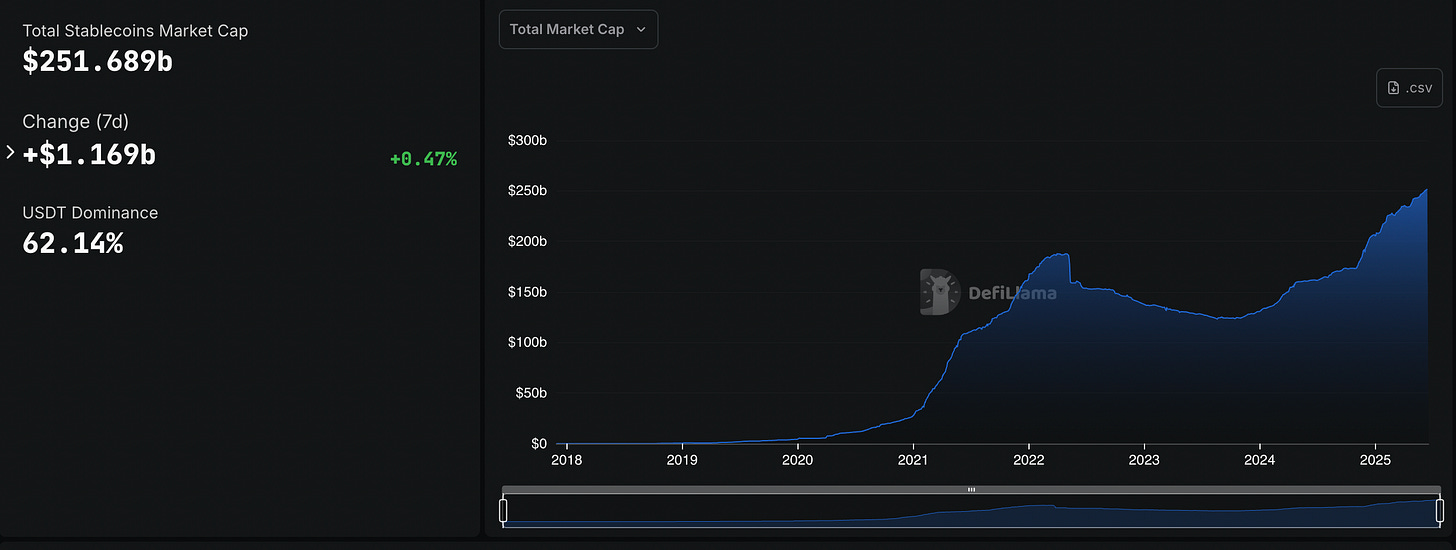Why the Senate Passing the Stablecoin Bill Just Triggered a $3 Trillion Wave
The GENIUS Act just broke the dam separating money and crypto
Another week, another win for crypto.
On Tuesday, the Senate passed the GENIUS Act with a strikingly bipartisan 68-30 tally. For a country that’s spent years lobbing political grenades across the aisle, it was a watershed moment. And while it still needs to clear the House before becoming law, the pressure is already building.
“This bill brings the U.S. one step closer to becoming the global leader in crypto,” sponsor Senator Bill Hagerty said minutes before the bill passed, adding that the vote marked an “inflection point for innovation.”
And somehow that doesn't seem to be hyperbole. The markets are proving that out.
Just a couple weeks removed from its IPO, stablecoin issuer Circle has now surged more than 500% amid growing optimism for crypto clarity. But the bullishness isn’t limited to one issuer or one stock. The entire stablecoin market, which currently sits around a $250 billion market cap, could be poised to balloon if large institutions feel safe launching their own — and it's already begun.
Watch our full episode to find out what happens next:
JPMorgan revealed on Monday that the financial giant will be launching its own version of a permissioned deposit coin for institutional clients, dubbed "JPMD," on Base. Then, the Wall Street Journal reported that Amazon and Walmart were exploring stablecoins of their own.
If that happens, the current market cap of stablecoins at $250 billion is sure to explode as dollars come onchain. The question is — at what clip?
Back in January, Omni co-founder Austin King told us, "I would not be shocked if total stablecoin adoption exceeded half a trillion dollars ... it might even hit a trillion.” A few weeks ago, during his Congressional testimony, Treasury Secretary Scott Bessent took it further.
“There is speculation that there will be up to $2 trillion in demand for U.S. dollars over the next several years from digital assets,” he said. He upped that number this week to reflect more recent reporting that the overall market cap could hit $3.7 trillion by the end of the decade.
It’s a forecast that Vishal Gupta, former head of USDC at Circle and Exchange at Coinbase, says is entirely plausible.
“The U.S. equity market is almost $50 trillion," he tells us. "The crypto market bounces between one and two. Stablecoins are a different market altogether.”
But for things to really take off, the U.S. still needs to wait for the House to take up the baton to pass its own version of the bill. Coinage spoke with Chair of the House Financial Services Committee French Hill who remained confident that the bill could get passed, along with a market infrastructure bill, by the August recess.
"We’ll consult with [the Senate] on how best to deal with it in the House,” Hill said. “We also will work market structure in the House and encourage senators to pursue a market structure framework of their own in the Senate.”
That strategy will become tricky. Coinbase CEO Brian Armstrong has advocated for bundling the two bills together, arguing that only passing the stablecoin bill may hurt enthusiasm or leverage to get the so-called CLARITY Act passed, which stand to remove crypto tokens — and Coinbase's role in selling them — from regulatory crosshairs.
But that gambit could backfire, leaving stablecoin clarity on the back burner. Considering Coinbase earns about half of Circle's USDC revenue as it stands, it may not be in a rush to see a bill deliver a green light for stablecoin competitors without ensuring it can also win a bigger victory. And with Circle stock up so much, investors are seemingly waking up to the opportunity in COIN. Shares closed up 16% in the last session.
But if you consider Circle is now nearly a $50 billion company to Coinbase’s $75 billion, it seems like the market is under appreciating the rest of Coinbase’s businesses — and its positioning. Particularly if it wins other financial institutions to Base — Coinbase stands to win not just on USDC (if they wind up using it) but also on the transactions on Base. (Perhaps this continues to be why other alts continue to get hammered.)
How to Play It:
One could seeminly short Circle and go long Coinbase here. There certainly seems like a realization underway. As our friends at Fundstrat point out, it’s likely something has to give.
My bet would be on investors realizing Coinbase is still trading below where it IPO’d in 2021.
For now, though, it remains abundantly clear that the passage of the GENIUS Act by the Senate marks more than just a legislative milestone — it marks the first real alignment between the U.S. government and the global crypto economy.
For over a decade, crypto has waited for this moment. It’s here now.
Buckle up.




